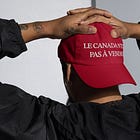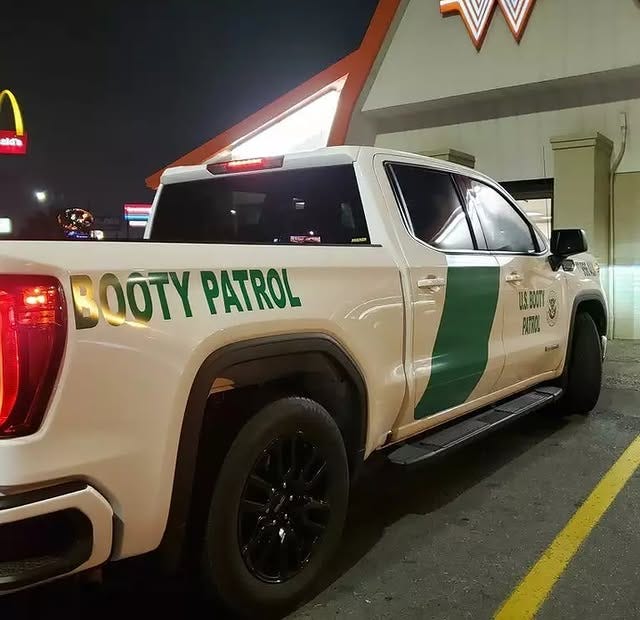This is government by cosplay
Plus: Amy Sherald’s largest-ever museum show offers a more expansive view of Black history
Hello, in this issue we’ll look at how Trump has staffed his TV-first administration and why the most profound thing about Amy Sherald’s latest exhibition might be the most mundane.
Scroll to the end to see: how I’m considering cosplaying a border patrol agent this summer ☀️
This is government by cosplay
President Donald Trump’s administration is making a big to-do about its deportation efforts, but much of it appears to be for show.
U.S. Immigration and Customs Enforcement, or ICE, tallies its arrests daily on X, but one number it doesn’t publicize is how many of those arrested migrants it ends up releasing back into the U.S. The agency has been found releasing some migrants as part of a monitoring program due to space constraints and court orders that prohibit indefinite detention, according to NBC News. It’s part of a larger trend.
A master showman, Trump handles the act of governing with the eye of a reality TV producer. The goal is to show his TV-viewing audience he’s busy at work, but it raises questions about whether this strategy prioritizes optics over effectiveness.
When it comes to deportations, the blueprint is Cops. One of the earliest reality shows, the program followed law enforcement as they busted bad guys. Similarly, the Trump administration has invited TV cameras for aligned outlets, like Fox News and Dr. Phil McGraw’s podcast, to follow officials along on raids. In one bizarre scene during a raid in Chicago, Dr. Phil questioned a man being arrested who asks him, “are you Dr. Phil?” When Phil asks the man how he knows him, he responds that he’s seen him “on TV.”
Before she was sworn in as Secretary of Homeland Security, former South Dakota Gov. Kristi Noem starred in a workforce recruitment campaign for her home state. Called “Freedom Works Here,” Noem played dress up in the ad campaign, wearing clothes for jobs like nurse, welder, dentist, electrician, accountant, construction worker, and cop to encourage people to move to South Dakota and work there.
The campaign was criticized for being the work of an out-of-state firm, ironic considering its goal of attracting workers to the state, and seen by some as an effort to raise Noem’s profile nationally. It also previewed Noem’s sartorial strategy for her new job: dress so obviously that viewers can guess what you do without a chyron.
Noem showed up for a hit on Fox News in green fatigues and a “U.S. Border Patrol” hat, and when she appeared on “Meet The Press” Sunday, she wore a cowboy hat and matching tan top. A review of media appearances by past DHS secretaries, both male and female, found recent secretaries tended to wear blazers to TV hits, but what Noem is doing is no different than lawmakers who dress like they’re going to a war zone when they visit the U.S.-Mexico border. It’s all a bit much.
The Trump administration’s response to the midair collision outside Washington’s Reagan National airport last week seemed to highlight the president’s penchant for TV-ready appointees. The administration’s on-air response came from the former host of “The Celebrity Apprentice” (Trump), a former “Fox & Friends Weekend” host (Defense Department Secretary Pete Hegseth), and a former “Real World: Boston” contestant (Transportation Secretary Sean Duffy).
Hosting a TV show should, of course, by no means preclude someone from public service, but in the case of someone like Hegseth, his resume seems like inadequate preparation to run a government agency with more employees than Walmart and more acres of property than the entirety of the commonwealth of Pennsylvania.
Hiring for communications over competence might make for good TV, but what’s lost when our government puts spectacle over all else?
Previously in YELLO:
Amy Sherald’s largest-ever museum show offers a more expansive view of Black history

Artist Amy Sherald, best known for her portrait of former first lady Michelle Obama, is out with her largest-ever museum show, a mid-career survey that collects nearly 50 paintings from 2007 to the present. While the show features her Obama portrait and her second most-famous work, a 2021 portrait of Breonna Taylor that graced the cover of Vanity Fair, perhaps the most striking thing about the exhibition is the mundane.
Amy Sherald: American Sublime opened late last year at the San Francisco Museum of Modern Art where it will run through March 9 before heading to the Whitney Museum of American Art in New York City and the National Portrait Gallery in Washington, D.C. As SFMOMA put it, Sherald has described her work as showing “Black figures not in contention, not racialized or politicized, but simply being.”
“By creating images of Black men, women, and children at ease, with few markers of place, time, or context beyond the clothes they wear, Sherald has invented an entirely new form of figurative painting,” SFMOMA director Christopher Bedford said in a statement. “Her approach goes beyond portraiture to enact new conditions for seeing, feeling, and understanding shared humanity.”
One of the show’s galleries, “An Inside and an Outside,” explores the divide between one’s public and private personas, SFMOMA says. Civil rights activist W.E.B. Du Bois spoke of a “double-consciousness” Black Americans experience, or the “sense of always looking at one’s self through the eyes of others.” Sherald’s work, the museum argues, captures both, allowing the subjects to hold the viewers’ gaze on their own terms.
Work like “A God Blessed Land (Empire of Dirt),” showing a farmer on his tractor, and Sherald’s 2017 portrait of a cowboy in an American flag shirt, challenge classic American motifs that are too often assumed to be Caucasian by default.

Among the new work in the exhibition are Sherald’s first triptych, “Ecclesia (The Meeting of Inheritance and Horizon)” (2024), and “Trans Forming Liberty” (2024), which shows a transgender model posing like the Statue of Liberty holding a torch full of flowers. In “American Grit” (2024), a boxer born without legs stares down the camera.
Americans expect a lot of their Black history, from the nation-defining fight for freedom to multi-generational battles over civil rights. While those stories are an indelible part of the American narrative, defining Black history solely in terms of tragedy and pain leaves out a much richer story. As Sherald’s work reminds us, Black history is too the story of cowboys, farmers, and boxers, of mothers, fathers, siblings, and friends.
Have you seen this?
A magnificent portrait of George Washington heads to Versailles for a makeover. The 1779 portrait, which usually hangs in the U.S. embassy in Paris, will be restored as part of a deal struck between the U.S. Department of State and France’s Center for Research and Restoration of Museums of France. [Artnet News]
Why so many shoppers view Target’s rollback on DEI as a betrayal. Although several companies have cut or scaled back DEI programs, Target’s reversal on DEI seemed to draw the greatest outrage. [Fast Company]
A historic D.C. Black church now owns the Proud Boys’ name. Metropolitan African Methodist Episcopal Church can seize any money the far-right group makes from selling merchandise. [Washingtonian]
Hostile takeover. No one voted for this man, but Elon Musk appears to be taking a chainsaw to the U.S. government even as his approval rating craters. [Whig]
History of political design
“Booty Patrol” truck (2023). A truck decked out to look like a U.S. Border Patrol truck but with the words "Booty Patrol" was once spotted in Brownsville, Texas, and a similarly decorated truck caught the attention of law enforcement in Florida, where officers said its design could be seen as impersonating law enforcement, according to the Miami Herald.
Like what you see? Subscribe for more:









